RACI Matrix
Contents |
Abstract
This article focuses on the RACI project management matrix. RACI being a synonym for Responsible, Accountable, Consulted, and Informed. [1]
Successful project organizations are the result of careful planning and collaboration of project team members. [1][2] Having clear roles and responsibilities is a crucial success factor for any kind of project. [1] Therefore, role definitions, responsibilities, and accountabilities must be determined to increase productivity, gain better results, and better communication with fewer misunderstandings and disruptions. The RACI matrix addresses this topic while providing a simple and effective tool for defining and documenting project roles and responsibilities. [3]
The RACI matrix brings structure and clarity to describing the roles that stakeholders might play within a project. [1][3] The overall goal of the RACI matrix is to map out every task, milestone or key decision involved in completing a project and assigns which project individuals, as well as stakeholders, are responsible, accountable, consult and inform statuses for different project activities. [4] A RACI matrix can be implemented at any time after a project has been conceived or is underway. [3]
The following article describes what a RACI matrix is, what RACI roles are, what the overall benefits of RACI are, and how the RACI matrix can put into practice. The article also discusses the considerations and rules of RACI and gives alternatives to the conventional RACI matrix. At the end of the article, RACI’s limitations are going to be explained in more detail. Project groups can use this article to identify their team structure, roles, and responsibilities to run team operations more smoothly.
The RACI Matrix
Definition of the RACI Matrix
The RACI matrix is a popular type of a Responsibility Assignment Matrix (RAM). RAM is a grid that shows the project resources assigned to each work package to illustrate the connection between work packages or activities and project team members. At a high-level, RAM defines all responsible of a project team group or unit within each component of the Work Breakdown Structure (WBS), while low-level RAMs are used within a group to designate roles, responsibilities, and levels of authority for specific activities. [1]
A WBS can be the underlying foundation for a RACI matrix as a WBS divides a project into its elements that need to be planned and controlled. [5] Therefore, the RACI matrix can be used to divide the project into subtasks and work packages as part of the structuring process. “Activities (tasks), roles and activities are basic elements of a process." [6] The RACI matrix is most useful for multiple people or groups assigned to a certain project activity. The matrix shows key activities as rows and participating parties as columns. For each participating party, the RACI matrix indicates the responsible, accountable, consulted, or informed. [7]
“The RACI matrix serves as the baseline of the communications plan by stipulating who receives information, how frequently, and at what level of detail.” To gain advantage of the RACI matrix, the matrix should be established by the end of the planning phase of a project or being used to get stuck projects in the execution phase moving again. As soon as a RACI matrix has been created, it should be published in the Project Charter document. [8]
Project planning has a crucial impact on the results of a project. [9] Therefore, it must clearly define all stakeholders as the drivers critical for project success. Project planning represents a forecast of the project development while objectives related to cost, time, and desired results are formulated. It requires a precise definition of project goals, performance measures, constraints, technological/operational alternatives, adaptability to unanticipated developments, and organizational and environmental considerations. Within project planning, the 'Fuzzy-Front-End' emerges from locating knowledge gaps, commonly spotted at the start of the project life cycle. The challenge of the 'Fuzzy Front End' is to show a myriad of ways to overcome uncertainty and ambiguity within the project planning phase. Within the 'Fuzzy Front End' commitments to involving resources are made. Thus the course of a project is determined by how well an organization manages the 'Fuzzy Front End'. [10]
The RACI matrix can be a great addition to the outcome of the 'Fuzzy Front End' as RACI clarifies project work expectations, verifies deliverables, and checks key-milestones, including specifications and requirements and resource planning. RACI can also check if SMART goals has been defined that are specific, measurable, achievable, realistic and time-based. Thereby the RACI user can quickly determine whether the expected deliverables, but also the resource planning can be achieved in a realistic and time-based manner. [10]
Roles of the RACI Matrix
The acronym RACI stands for: Responsible, Accountable, Consulted, and Informed. [1] The following table is going to describe the different functions of the four initials.
| Responsible | “Person who must perform the work, responsible for the activity until the work is finished and approved by an accountable. There is typically one person responsible for an activity.“ [11] |
| Accountable - also Approver or final Approving Authority | “Person who must approve the work performed by the person responsible for an activity, and who becomes responsible for it after approval. There must be one and only one accountable for each activity.“ [11] |
| Consulted | “This role includes all the people whose opinion is sought while carrying out the work, and with whom there is two- way communication.“ [11] |
| Informed | “Person who is kept up-to-date about the progress of an activity and the results of the work, and with whom there is just one-way communication. There may be more than one person informed of the work of an activity.“ [11] |
Assigning RACI roles to a project example
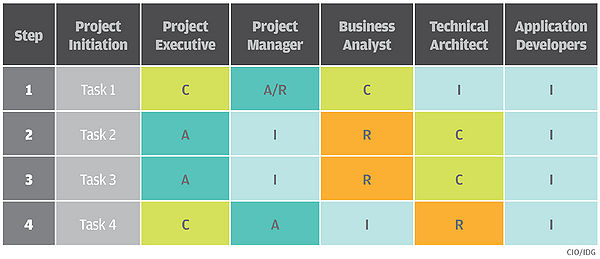
When creating a RACI matrix, it is important to assign the correct RACI roles to the corresponding project team roles. In the following section, the project roles and their indicators from Figure 1 are going to be highlighted in more detail. Figure 1 illustrates such a simplified RACI matrix and refers to a conventional project team structure within an IT project.
As shown in Figure 1, the project executive and project manager are often assigned the role of the accountable as they are held responsible for the planning, procurement, and execution of a project. At the same time, a project executive also assumes the role of the consulted, since project executives often have a wealth of experience that can serve the project to be managed. In addition to the role of the accountable, the project manager, often assumes the role of the informed, as a project manager has to compile all project-related information.
In this example, the business analyst and technical architect are responsible for the implementation of the individual work packages. Also, both roles include some consulting as well as informing activities. The business analyst consults the project manager in the first task and is getting informed by the technical analyst on task four. While the technical analyst is getting informed in task one and consulting the business analyst in tasks three and four.
Furthermore, the application developers are only going to be informed about the progress of the task. They do not have an active role in this project. That means that the developers do not have to contribute to the project but must be informed about definite activities. In some cases, the project manager also overtakes the role of the responsible. This can happen when the task is not extensive and can be performed very well alone. In this example, the project manager also has assistance from the project executive and business analyst whom both act as consultants.
Benefits of the RACI Matrix
The use of a RACI matrix can bring benefits to a project. The following section is going to provide the most important benefits of the RACI matrix.
- Streamline Communication
- Providing a RACI matrix can be useful for focusing on the entire lifecycle of a project. Instead of involving every single person in every single decision, one can simplify communication by involving the right people at the right time and speed up approval and decision-making.
- Avoid People Overload
- Different stakeholders often perceive complex problems differently. [2] In most cases, the management tries to take all different opinions into account. However, this can end in misery. RACI solves this problem as the matrix distinguishes between Consulted and Informed and can consequently separate those involved in the feedback from those who are just being informed about the progress of the task.
- Avoid Work Overload and Silos
- Project managers often have multiple tasks at the same time, take on a lot of responsibility, and cover multiple positions in a project. The RACI matrix can be a useful tool to delegate and avoid project manager burnout. It also helps avoid a single point of failure, where all knowledge and responsibility for a task rests on one person, creating silos.
- Additionally, RACI informs the organization about its employee workloads as it shows which roles are assigned to each person. [12] RACI shows a clear advantage over project management software and tools like JIRA, Scoro, and ProofHub. These tools are capable of organizing projects of a company or group while including features like projects and tasks, contact management, quotes, team collaboration, billing, and reporting. However, these tools miss out on any kind of workload management. RACI does address workload management by simply applying the RACI initials in its matrix.
- Set Clear Expectations
- Creating a RACI matrix in the planning phase of a project can be useful to set expectations about who will lead or be responsible for future work. People involved in the RACI matrix should be able to identify where they need to be involved. This is especially important if the project team consists of internal and external resources. Here, the project must ensure clear divisions of roles and expectations. [1]
- It can also help avoid confusion by showing who is ultimately responsible for completing a task. It is especially useful to set expectations for higher-level stakeholders who will be informed about the project. It will allow stakeholders to know what information they will receive as part of the project.
- Ensure a Smooth Transition
- RACI ensures a smooth transition and handoff when there is turnover. [13] Therefore, the RACI matrix is used as documentation to show all responsibilities as well as activities of the project up to the respective transition. This allows the following project management to get in contact with the previous project members to solve e.g. open questions or problems.
- Early Deliverable and Work-Package Review
- When a RACI matrix is shared with all the stakeholders within a project team, it adds value by spotting out any missing deliverable requirements or work-packages, missing roles, missing stakeholders. Thus, it provides an opportunity for early correction of deliverable requirements and work-packages. [14][15]
Application of the RACI Matrix
How to use and create a RACI Matix
A RACI matrix can be applied to all projects in an organization, although they can be quite different when comparing them to each other as project sizes, roles, as well as deliverables and work-packages, differ from each other. The process of developing a RACI matrix is divided into five steps; Task Identification, Stakeholder Identification, Role Definition, Matrix Review, and Publication. The following section highlights these steps in more detail. [16]
- 1. Task Identification
- Use a WBS as the underlying foundation for the identification of all the tasks involved in delivering the project and divides the project into phases, deliverables, and work packages as part of the structuring process. It helps the project team to develop an objective, rational view of the amount of work required. [2] After, list all identified tasks on the left-hand side of the chart in completion order. “In IT projects, this is most effectively addressed by incorporating the product lifecycle steps and deliverables.” [3] The following Figure 2. shows a simplified WBS and gives a brief overview of how such a WBS can serve as an underlying foundation for the RACI's task identification process.
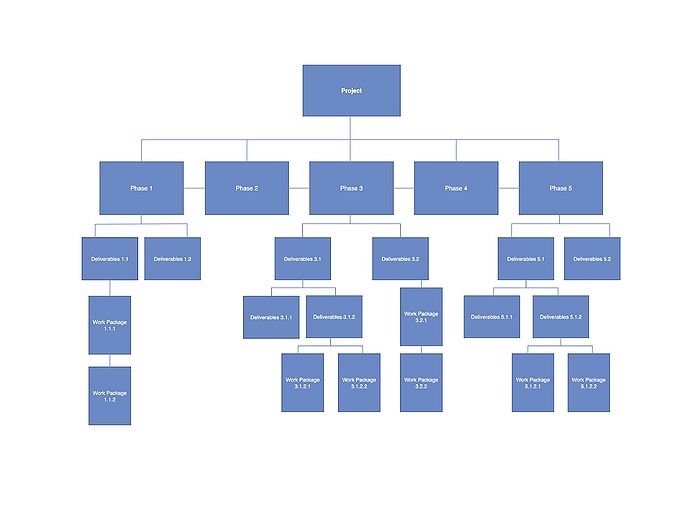
- 2. Shareholder Identification
- Identify all the project stakeholders and list them along the top of the chart. Therefore, stakeholder identification requires to use different inputs to identify the shareholders which can influence the work and outcomes of the project. Common inputs to identify which stakeholders are involved in the projects are a project charter, business document, project management plan, general project documents, agreements, and organizational process assets. [1] Figure 3. provides an overview of how to analyze and classify project stakeholders for the RACI matrix. Here, the goal is to understand each stakeholder individually to be able to tailor interactions according to the stakeholder's desires and influence. [18]
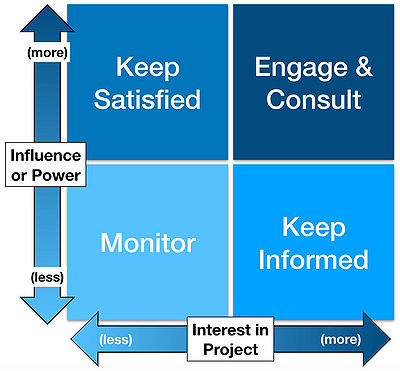
- 3. Role Definition
- Assign RACI to each role and task of the project and complete the cells of the model while identifying who has responsibility, accountability and who will be consulted and informed for each project task. [3] According to the Project Resource Management Overview provided by the Project Management Institute, resource management planning requires different inputs to allocate project resources. Along with the project charter, project management plan, project documents, enterprise environmental factors, and organizational process assets, project roles for the RACI matrix can be determined. For the estimation of resources, tools and techniques like expert judgment, bottom-up estimating, analogous estimating, parametric estimating, data analysis, project management information system, and meetings are used.. [1] For more information about the estimation of resources, refer to the source 'Guide to the Project Management Body of Knowledge'. In Figure 4. the inputs, tools and techniques, and outputs of the Plan Resource Management process are depicted.
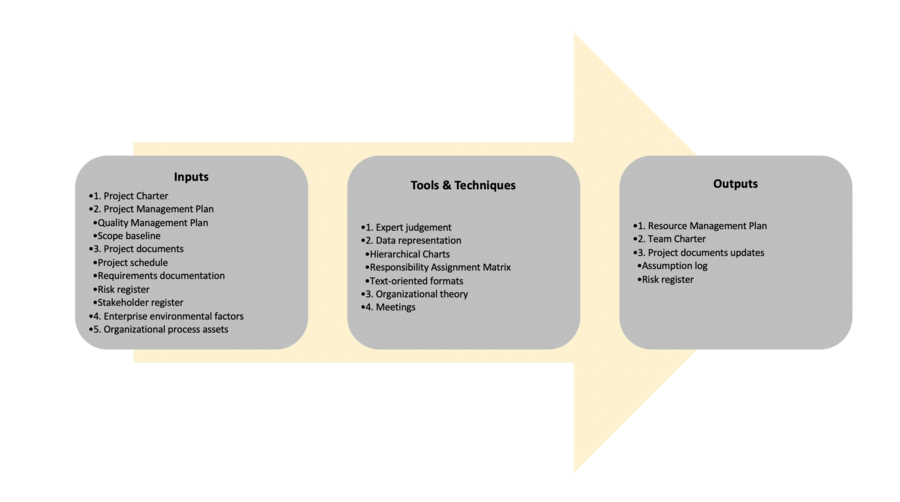
- 4. Matrix Review
- No tasks should have more than one accountable stakeholder. Reviewing the matrix ensures that every task has at least one accountable stakeholder for any given task. Therefore, resolve any conflicts where there is more than one for a particular task. [3]
- 5. Publication
- Share and discuss the RACI model with all involved stakeholders at the start of the project. If all involved stakeholders agree with it all involved stakeholders know what to do. “This includes resolving any conflicts or ambiguities.” [1][3] Please refer to chapter 3.2 of this article to learn more about how to solve conflicts or ambiguities within a RACI matrix. Also, a RACI matrix should be updated as the project progresses.
Considerations and Rules to create a RACI Matrix
For the RACI matrix to be most effective there are a few things to consider. Solely creating a RACI matrix is not enough. The respective RACI creator(s) must ensure that the matrix maps to a successful strategy in which understanding and defining roles and responsibilities are part of the foundation. [18] Therefore, conflicts and ambiguities must be avoided. The following section serves as an instruction manual for the creation of a RACI matrix and highlights all considerations that need to be taken into account:
- Assign only one accountable per task as the accountable takes the decisions and actions on the project. Having multiple accountable causes confusion as different goals and expectations point in different directions. It is paramount to clarify who the project accountable is.
- Every task needs a responsible and accountable role assigned to it. If one of the two roles is missing it will lead to ambiguities within the project.
- Every task should only have one responsible as too many responsible might slow down the process.
- Assign only as many people as necessary to avoid inefficiencies. Many people try to control, influence, or work on something, with the quality of the final product suffering as a result. [13]
- If there is a quick and manageable task, the responsible could also be the accountable.
- Do not assign too many consults as it could slow the task completion as consulting with several people before completing a task can take time. Additionally, conflicting input on how to complete the task might be another waste of time. [12]
- Keep people informed and up-to-date. Perhaps there is no need to consult people, so they only have to be informed. Ensure that there is a person in place notifying others. If not, there could arise problems relating to a lack of communication. [12]
The following section is going to highlight some general rules of how to resolve conflicts and ambiguities in a RACI matrix. That can be achieved by checking across each row and up and down each column for the following:
- No Empty Cells: Are all RACI rows and columns filled in?
- Check Responsibilities: Check if the stakeholders who are performing the work have too much work of the project assigned to them.
- One Accountable for Every Task: Does every task has only one accountable?
- Check Authority of the Accountable: Check that the people who have been marked as accountable have the authority to sign off on the task.
- Push Authority: Try to push authority down the organization by assigning A’s to the lowest rank people possible.
- Buy-in: Does each stakeholder understand and agree with the role that they are specified to play in this version of the model? Create the RACI chart with the entire team to ensure their buy-in.
- Update Regularly: Make sure to distribute the RACI matrix regularly and make updates based on feedback.
Self-Assessment of the RACI Matrix
The RACI self-assessment has been developed to determine how closely existing management practices and procedures correspond to the elements of the self-assessment. It aims to improve the understanding of requirements and elements of RACI based on best practices, standards, and business process architecture, design, and quality management. [20] Therefore, criteria of requirements and elements of the RACI matrix have been rephrased in the format of a self-assessment questionnaire including a seven-criterion scoring system.
Even with a limited background of the RACI matrix, the RACI creator(s) can quickly review existing operations to determine how they measure up to the standards. Using the self-assessment can serve as the starting point of a 'gap-analysis' to identify management tools or system elements that might usefully be implemented in the organization to help improve overall performance. [20]
While facilitating a self-assessment of the RACI matrix a project team should try to concentrate on the question 'In my belief, the answer to this question is clearly defined' while scoring on a scale of '1' to '5' all seven-criterion. A score of '1' would mean that the answer is not clear at all, where a '5' would mean the answer is totally clear. Leave empty when the question is not applicable or the project team does not want to answer it. After the project team has responded to all the appropriate statements in each section the RACI matrix scorecard will give a clear presentation of which RACI matrix areas need attention. Figure 5. is going to illustrate such a RACI matrix scorecard example. [20]
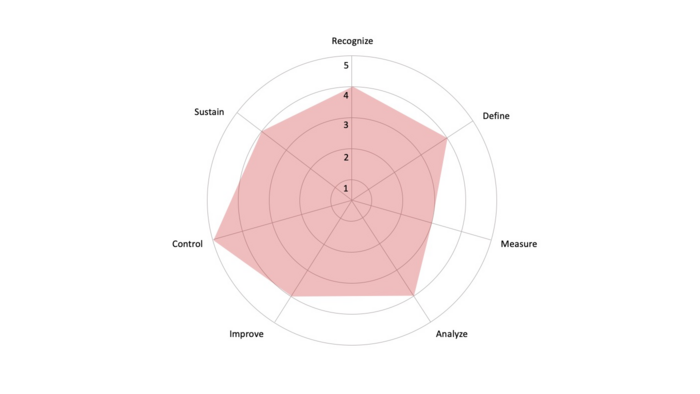
Extension of the RACI Matrix
There are several variants of the original version of the RACI matrix. Some are based on extending the number of RACI roles to be considered for every activity, e.g., RACIO, RASCI, or RACI-VS. Others give different meanings to the RACI initials as there might be roles that do not fit the mold. Especially in large projects with many moving parts, reducing clutter can improve efficiency and clarity. In this case, an alternative model of RACI could work well. The following section is going to present different alternatives to the RACI matrix. [21][13]
- RACIO
- RACIO is a RACI alternative that extends the RACI roles by including “O-Omitted” designation. It allows excluding stakeholders that do not align perfectly with the RACI model. For instance, there might be no stakeholder who needs to be informed or consulted. So, if a task does not require every stakeholder to take an active role, a stakeholder can be assigned to “O” who can ignore that task. [13][11]
- RASCI
- The RASCI matrix is extending the number of RACI roles by including “S-Support” designation. This function might be interesting especially to IT organizations, where work can usually be delegated to other people to complete a certain activity. Therefore, the “Support” designation is used to assign people who may assist in completing an activity. In that way, the responsible person, who must perform the work, can delegate work to the supporting role. [11]
- RACI-VS
- The RACI-VS matrix is extending the number of RACI roles by including “V-Verification” and “S” a “Sign-Off” designation. “To overcome any possible deficiencies in any task, RACI-VS allows marking those roles as “V” who will scrutinize the quality and correctness of a given specific task. And to supervise both “V” and “R” & “A” roles, there will be a role “S”-Sign-off who will provide the task completion verdict by approving it.” [22][11]
There are also other variations of the RACI matrix that give different meanings to the RACI designations e.g. DRASCI, DACI and RATSI. To learn more about those RACI variations please refer to the book ’On the Move to Meaningful Internet Systems: OTM 2012’ stated in the Annotated Bibliography of this article.
Limitations of the RACI Matrix
There are a few limitations to using a RACI matrix. The following section is going to highlight RACI's limitations in more detail:
- RACI will not fix a dysfunctional Team
- To ensure the overall effectiveness of the matrix, RACI needs to have a functional team. RACI does not address and solve project team issues e.g., lack of trust, disagreement, and tension, low engagement, poor morale, or a lack of team and/or task skills. RACI is not a tool that fixes dysfunctional teams. RACI improves communication flow in a cohesive group. [21][12]
- RACI can be confusing
- RACI can be confusing as it explains each person’s role, but it does not clarify actions that team members need to take. Some stakeholders feel that it is not clear whether the responsible or accountable plan the task. So, there should be clarity about who is planning the roles. Also, the consulting role is unclear. Nobody knows if the consulted will only give direction when asked or whether they will offer direction when they feel it is suitable, and make sure their input is implemented. Therefore, the project manager and the person consulted need to decide which approach the consultant will take.
- Is the Responsible not Accountable?
- RACI gives the impression that the responsible is not accountable. Thus, the physical separation of the two roles gives the impression that only one person can be responsible or accountable at the same time. It is important to understand that the responsible is indeed accountable for processing the work. One could argue that the responsible is rather task-oriented accountable while the accountable is much more responsible for the overall project delivery. However, RACI reaches its limits here, and the question of who is responsible for what should be clarified individually between the different roles.
- RACI’s Variations and Alternatives
- Depending on the setup of the project team, the RACI matrix has variations and alternatives. [21][23] Having different variations and alternatives of one tool is confusing. It appears that these variations and alternatives are compensating for the original matrix design. “If it had been designed well, one version of the matrix would suffice.” [12] Conversely, it can be argued that the RACI model is flexible and its project team members can be delegated according to the project goal. So if the aspects of RACI are too vague, consider it as an opportunity to think out of the box and use the tool to adapt it to the project-related needs.
- RACI does not account for the Approval Process on Stakeholders as well as Tasks or Deliverables
- In a RACI matrix, it can quickly happen that a detailed stakeholder analysis is not performed and project roles are assigned at will or even worse by gut feeling. The same is true for the task definition. Often, the approval process for tasks or deliverables is not taken into consideration and process mapping is completely omitted. RACI does not replace a stakeholder analysis or a process mapping but integrates it into a matrix. Therefore, it is important to use the RACI matrix not as a substitute but rather as a tool for additional definition.
Annotated Bibliography
- Project Management Institute, Inc.. (2017). Guide to the Project Management Body of Knowledge (PMBOK® Guide). 6th Edition. Newtown Square: Independent Publishers Group.
- - The 'Guide to the Project Management Body of Knowledge' includes a complete collection of relevant processes, best practices, guidelines, and terminologies within the project management industry. Chapter nine explicitly deals with the RACI matrix and explains what is behind the project management tool. Furthermore, the book provides detailed information about project resource allocation which is especially important in the role definition of the RACI matrix.
- Blokdyk, G. (2020). RACI Matrix: A complete Guide. 2nd Edition. Brendale: The Art of Service.
- - The 'RACI Matrix: A complete Guide' handbook describes how a RACI-assessment improves the understanding of requirements and elements of the RACI matrix. Furthermore, it provides a hands-on guideline of how to create a RACI matrix. On top of that, the book gives an overview of best practices and standards in business process architecture, design, and quality management.
- Costello, T. (2012). RACI - Getting projects "unstuck". EEE Computer Society. Volume 14, 2nd Issue. Washington: IT Professional.
- - This journal article explains how the RACI matrix can help to get stuck projects moving again. Furthermore, it addresses the basic principles of RACI, gives an overview of RACI's rules and implementation guidelines. The Article also outlines why RACI is so important for the PMO office and its CIO.
- Meersman, R. et al.. (2012). On the Move to Meaningful Internet Systems: OTM 2012. 2nd Edition. Heidelberg: Springer-Berlin Heidelberg.
- - This book introduces alternatives to the conventional RACI matrix. It also discusses its organizational need and its influence on business processes. Furthermore, it gives a general overview of how business process models influence RACI's expressiveness.
- Norman, E. S., Brotherton S. A. and Fried R. T. (2008). Work Breakdown Structures: The Foundation for Project Management Excellence. 1st Edition. Hoboken: John Wiley & Sons.
- - This book provides knowledge about how Work Breakdown Structures work. It analyzes the process of developing a Work Breakdown Structure and also gives information on how to implement it in any project. This book can serve as the basis for the task identification process of a RACI matrix. The book also provides some insight into new work breakdown structure approaches and their elements.
References
- ↑ 1.00 1.01 1.02 1.03 1.04 1.05 1.06 1.07 1.08 1.09 1.10 Project Management Institute, Inc.. (2017). Guide to the Project Management Body of Knowledge (PMBOK® Guide). 6th Edition. Newtown Square: Independent Publishers Group.
- ↑ 2.0 2.1 2.2 Züst R. and Troxler P. (2006). No More Muddling Through: Mastering Complex Projects in Engineering and Management. 2nd Edition. Zürich: Orell Füssli Verlag.
- ↑ 3.0 3.1 3.2 3.3 3.4 3.5 3.6 3.7 Kantor, B. (2018). The RACI matrix: Your blueprint for project success [online]. Available at: https://www.cio.com/article/2395825/project-management-how-to-design-a-successful-raci-project-plan.html (Accessed: 02/08/2021)
- ↑ Chung, E. (2017). RACI vs RAM for PMP Exam [online]. Available: https://edward-designer.com/web/raci-vs-ram-for-pmp-exam/ (Accessed: 02/05/2021)
- ↑ Racichart.org. (2021). WBS [online]. Available: https://racichart.org/wbs/ (Accessed: 02/07/2021)
- ↑ Ying L., Lijun X. and Wei S. (2009). Configuration Management Process Design and Implementation. Sanya: IEEE.
- ↑ Averdunk, I. (2021). Clarify roles and responsibilities by using a RACI matrix [online]. Available: https://www.ibm.com/garage/method/practices/manage/raci-matrix/ (Accessed: 02/08/2021).
- ↑ Friedman, S. (2008). Roles, Responsibilities, and Resources: Best Practices in Managing People [online]. Available at: https://www.pmi.org/learning/library/best-practices-managing-people-quality-management-7012 (Accessed: 02/08/2021).
- ↑ Serrador, P. (2012). The importance of the planning phase to project success [online]. Available at: https://www.pmi.org/learning/library/importance-planning-phase-project-success-6021 (Accessed: 02/20/2021).
- ↑ 10.0 10.1 PMO Advisory Admin. 2019. What is “Fuzzy Front End” for Portfolio, Program, & Project Management [online]. Available at: https://www.pmoadvisory.com/blog/managing-the-fuzzy-front-end-with-portfolio-program-project-management/ (Accessed: 02/18/2021).
- ↑ 11.0 11.1 11.2 11.3 11.4 11.5 11.6 Cabanillas, C., Resinas, M. and Ruiz-Cort ́es, A. (2014). Mixing RASCI Matrices and BPMN Together for Responsibility Management?. [online]. Available at: http://citeseerx.ist.psu.edu/viewdoc/download;jsessionid=02D0EB439057B7854B064EE0B5AB6F16?doi=10.1.1.468.341&rep=rep1&type=pdf (Accessed: 02/11/2021).
- ↑ 12.0 12.1 12.2 12.3 12.4 Santos Delos, J.M. (2020). Understanding Responsibility Assignment Matrix (RACI Matrix) [online]. Available at: https://project-management.com/understanding-responsibility-assignment-matrix-raci-matrix/ (Accessed: 02/02/2021).
- ↑ 13.0 13.1 13.2 13.3 Lucid Content Team. (2021). How the RACI Matrix Will Streamline Your Project Lifecycle [online]. Available at: https://www.lucidchart.com/blog/what-is-a-raci-matrix (Accessed: 02/09/2021)
- ↑ Kahn, P. M. and Quranshi, K. A. (2014). Impact of RACI on Delivery & Outcome of Software Development Projects [online]. Rohtak: Fourth International Conference on Advanced Computing & Communication Technologies. Available at: https://ieeexplore-ieee-org.proxy.findit.dtu.dk/stamp/stamp.jsp?tp=&arnumber=6783449 (Accessed: 02/09/2021).
- ↑ Haworth, S. (2021). Eine Zuordnungsmatrix Für Zuständigkeiten Anlegen (RACI-Matrix) [online]. Available at: https://thedigitalprojectmanager.com/de/raci-matrix-erstellen/ (Accessed: 02/09/2021).
- ↑ EPM (2021). How to Use a RACI Matrix | RACI Model [online]. Available at: https://expertprogrammanagement.com/2010/01/how-to-use-a-raci-matrix-raci-model/ (Accessed: 02/10/2021).
- ↑ Prakash, V. (2019). How to create a Work Breakdown Structure? [online]. Available at: https://www.pmwares.com/blog/how-to-create-work-breakdown-structure/ (Accessed: 02/13/2021).
- ↑ 18.0 18.1 Project Management Institute, Inc.. (2017). The Standard for Program Management. 4th Edition. Newtown Square: Independent Publishers Group.
- ↑ Warner, M. H. (2018). Analyzing and Classifying Project Stakeholders [online]. Available at: https://www.theprojectmanagementblueprint.com/blog/stakeholder-management/stakeholder-power-interest-grid (Accessed: 02/13/2021).
- ↑ 20.0 20.1 20.2 20.3 Blokdyk, G. (2020). RACI Matrix: A complete Guide. 2nd Edition. Brendale: The Art of Service.
- ↑ 21.0 21.1 21.2 Meersman, R. et al.. (2012). On the Move to Meaningful Internet Systems: OTM 2012. 2nd Edition. Heidelberg: Springer-Berlin Heidelberg.
- ↑ Interfacing. (2021). RACI vs. RAPID Responsibility Matrix [online]. Available at: https://www.interfacing.com/rapid-vs-raci (Accessed: 02/13/2021).
- ↑ CSI Team. (2016). How to use a RACI chart to define content roles and responsibilities [online]. Available at: https://contentstrategyinc.com/how-to-use-a-raci-chart-to-define-content-roles-and-responsibilities/ (Accessed: 02/13/2021).